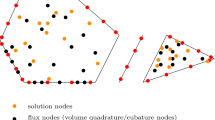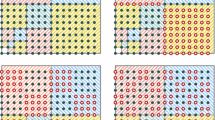Abstract
Logarithmically optimal in theory and fast in practice, direct algorithms for implementing a tensor product finite element method (FEM) based on tensor products of 1D high-order FEM spaces on multi-dimensional rectangular parallelepipeds are proposed for solving the N-dimensional Poisson-type equation \( - \Delta u + \alpha u = f\) (\(N \geqslant 2\)) with Dirichlet boundary conditions. The algorithms are based on well-known Fourier approaches. The key new points are a detailed description of the eigenpairs of the 1D eigenvalue problems for the high-order FEM, as well as fast direct and inverse eigenvector expansion algorithms that simultaneously employ several versions of the fast Fourier transform. Results of numerical experiments in the 2D and 3D cases are presented. The algorithms can be used in numerous applications, in particular, to implement tensor product high-order finite element methods for various time-dependent partial differential equations, including the multidimensional heat, wave, and Schrödinger ones.








Similar content being viewed by others
REFERENCES
P. G. Ciarlet, Finite Element Method for Elliptic Problems (SIAM, Philadelphia, 2002).
P. N. Swarztrauber, “The methods of cyclic reduction, Fourier analysis and the FACR algorithm for the discrete solution of Poisson’s equation on a rectangle,” SIAM Rev. 19 (3), 490–501 (1977).
E. S. Samarskii and E. S. Nikolaev, Numerical Methods for Grid Equations, Vol. 1: Direct Methods (Birkhäuser, Amsterdam, 1989).
Y.-Y. Kwan and J. Shen, “An efficient direct parallel spectral-element solver for separable elliptic problems,” J. Comput. Phys. 225, 1721–1735 (2007).
B. Bialecki, G. Fairweather, and A. Karageorghis, “Matrix decomposition algorithms for elliptic boundary value problems: A survey,” Numer. Algorithms 56, 253–295 (2011).
V. Britanak, K. R. Rao, and P. Yip, Discrete Cosine and Sine Transforms: General Properties, Fast Algorithms and Integer Approximations (Academic Press—Elsevier, Oxford, 2007).
A. A. Zlotnik and I. A. Zlotnik, “A fast direct algorithm for implementing a high-order finite element method on rectangles as applied to boundary value problems for the Poisson equation,” Dokl. Math. 95 (2), 129–135 (2017).
Yu. A. Kuznetsov, “Numerical methods in subspaces,” Computational Processes and Systems, Ed. by G. I. Marchuk (Nauka, Moscow, 1985), Vol. 2, pp. 265–350 [in Russian].
K. Du, G. Fairweather, and W. Sun, “Matrix decomposition algorithms for arbitrary order C0 tensor product finite element systems,” J. Comput. Appl. Math. 275, 162–182 (2015).
E. G. Dyakonov, Optimization in Solving Elliptic Problems (CRC, Boca Raton, 1996).
A. Zlotnik and I. Zlotnik, “Finite element method with discrete transparent boundary conditions for the time-dependent 1D Schrödinger equation,” Kinetic Relat. Models 5 (3), 639–667 (2012).
B. Ducomet, A. Zlotnik, and I. Zlotnik, “The splitting in potential Crank–Nicolson scheme with discrete transparent boundary conditions for the Schrödinger equation on a semi-infinite strip,” ESAIM: Math. Model. Numer. Anal. 48 (6), 1681–1699 (2014).
Y. M. Altman, Accelerating MATLAB Performance: 1001 Tips to Speed up MATLAB Programs (Chapman and Hall/CRC, New York, 2014).
S. Eddins, Timing the FFT. http://blogs.mathworks.com/steve/2014/04/07/timing-the-fft/.
Z. Průša, P. L. Søndergaard, N. Holighaus, C. Wiesmeyr, and P. Balazs, “The large time-frequency analysis toolbox 2.0,” in Sound, Music, and Motion (Springer, Berlin, 2014), pp. 419–442.
M. Frigo and S. G. Johnson, “The design and implementation of FFTW3,” Proc. IEEE 93, 216–231 (2005).
K. Du, G. Fairweather, Q. N. Nguyen, and W. Sun, “Matrix decomposition algorithms for the C0-quadratic finite element Galerkin method,” BIT Numer. Math. 49, 509–526 (2009).
Funding
The publication was prepared within the framework of the Academic Fund Program at the National Research University Higher School of Economics in 2019–2020 (grant no. 19-01-021) and was supported by the Russian Academic Excellence Project “5-100” and the Russian Foundation for Basic Research, grant no. 19-01-00262.
Author information
Authors and Affiliations
Corresponding authors
Rights and permissions
About this article
Cite this article
Zlotnik, A.A., Zlotnik, I.A. Fast Fourier Solvers for the Tensor Product High-Order FEM for a Poisson Type Equation. Comput. Math. and Math. Phys. 60, 240–257 (2020). https://doi.org/10.1134/S096554252002013X
Received:
Revised:
Accepted:
Published:
Issue Date:
DOI: https://doi.org/10.1134/S096554252002013X




